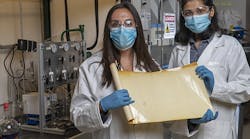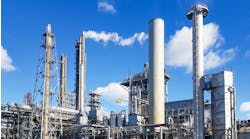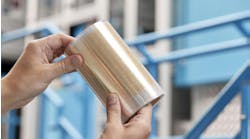Processing Equipment: New Separation Options Beckon
Separation operations remain an indispensable part of many processes. Because current separation technology often involves substantial investment and high energy consumption, work on improved options is ongoing. Membranes represent one area of considerable promise. Indeed, advancements in membrane separation could revolutionize the chemical industry in five-to-ten years, hope researchers in the United Kingdom and United States. Meanwhile, dividing wall column (DWC) technology is pushing the boundaries of what distillation can achieve.
Some membrane efforts — such as a project headed by Davide Mattia, professor and dean (research), Faculty of Engineering & Design, University of Bath (UB), Bath, U.K. — go beyond developing technology and aim to bolster the ranks of specialists skilled in applying the technology. “A key aspect of this project is training of the next generation of membranologists. Because of the interactions the universities involved have with industrial companies, in the end we will have a significant number of very talented people who can be deployed in both academic and industrial settings. So much closer links will be forged,” he notes.
Fresh blood already is invigorating membrane research, adds M.G. Finn, professor and chair of the School of Chemistry and Biochemistry at Georgia Institute of Technology (Georgia Tech), Atlanta. “It’s an interesting time now because a number of young synthetic chemists trained in complex organic chemistry are moving into the field of polymers. They bring state-of-the-art knowledge of molecule-making and, so, a lot of new materials that were previously unimaginable are being created,”
Separating Crude Oil
Finn’s team together with collaborators at ExxonMobil and Imperial College, London, have developed new membrane technology that potentially could replace some conventional heat-based distillation processes in the future.
Unexpectedly, the researchers found the materials needed a small amount of structural flexibility to improve size discrimination, as well as the ability to be slightly “sticky” toward certain types of molecules that appear in abundance in crude oil.
“When we took on a more-complex feed, crude oil, we got fractionalization that looked like it could have come from a distillation column, indicating the concept’s great potential,” says Finn.
The researchers described the technology in an article in the July 17, 2020, issue of Science. That paper is believed to be the first report of a synthetic membrane specifically designed for the separation of crude oil and crude-oil fractions (Figure 1).
Since then, much of the research effort has gone into creating alternative polymer structures and understanding the mechanisms by which they work.
“What we are finding is that polymer dynamics are as important as pore structures, a concept that has not been emphasized in the field of small-molecule membrane separations,” notes Finn.
His team’s materials differ from traditional polymers of intrinsic microporosity because they are not ladder polymers and, so, may have greater dynamic motion. A little dynamic motion is good but too much isn’t, he explains.
The work has focused far more on understanding how different chemical linkages in the polymers affect their performance.
“It’s surprising how well some of these do work,” Finn adds, citing as an example his team’s earlier use of carbon-nitrogen bonds to stitch the polymer together: “These bonds have just the right amount of motion — rotation around the C-N bond — to impart useful dynamics to the polymer as a whole. However, while it is relatively easy to predict how small molecules twist and change shape, it’s more difficult for very large molecules such as polymers. So we are learning more about polymer dynamics all the time.”
Another interesting finding is that a rigid pore structure of a specific size isn’t necessary in a membrane. As an analogy, he mentions the ability to limit a person’s passage through a house by being able to predict and control both how wide the doors are and the ease of opening them.
Figure 1. New membrane is the first specifically designed for separation of crude oil fractions. Source: Georgia Tech/M. G. Finn.
“If it’s easier to build a house with doors rather than one with open passages, this would allow us to control the size and shape of the molecules that are allowed to go through. It’s still early days,” he stresses.
Even so, the team is in the process of patenting various kinds of structures with different linkages. “An overall design goal is ‘frustrated packing’ — making polymers that can’t pack close together so holes are formed in the material — but I can’t really say more until the patent is published,” he notes.
Industrial companies are funding much of the research. For example, ExxonMobil, Irving, Texas, brings data, conceptual insights and overall membrane experience. Its relationship with Georgia Tech goes back nearly 15 years and has produced innovations in other separation technologies, including a new carbon-based molecular-sieve membrane that could dramatically reduce the energy required to separate a class of hydrocarbon molecules known as alkyl aromatics.
“We are sensitive to what the companies regard as important, so our polymers have to be scalable and easy to manufacture. We also have an embarrassment of engineering riches at Georgia Tech, so we can tap into them, too. Of course, the potential here goes way beyond petrochemical applications,” he says.
Finn, while emphasizing the need for his new chemists to be grounded in practical applications of their inventions, also has some advice for process engineers: “Don’t be too afraid of disrupting your process a little bit if there’s a new material out there that could be of benefit.”
Looking For Broad Insights
Meanwhile in February, the £9-million ($12-million) SynHiSel project to explore how to improve the selectivity of membranes and apply this knowledge to a range of industrial processes begins at U.K. universities. The U.K.’s Engineering and Physical Sciences Research Council separation processes fund is providing £7.3 million ($9.5 million), with the rest coming from universities and industrial collaborators.
“Membrane-based separations tend to be energy efficient compared to other methods, but they are often highly specialized to a single purpose. We aim to work out how to maximize that energy efficiency advantage by investigating the fundamentals of membranes to uncover universal characteristics that can be applied to a range of real-world uses. This will save time, cost and reduce waste in developing individual applications in future,” explains UB’s Mattia, adding that having a broad sense of the fundamental factors at play will be a significant advance.
The aim of the SynHiSel program, like the one at Georgia Tech, is not only to come up with scientific innovations but also to develop a new generation of talent in the field. In effect, the program will act as the U.K.’s national membrane center. The academic and industrial partners will provide grants to support an initial group of 11 new PhD students; PhDs and post-doctoral research associates will gain valuable experience as part of the multidisciplinary research groups and receive dedicated training and professional development opportunities.
With the backing of companies including Evonik Industries, Dupont Teijin Films (U.K.), Pall Europe, BP, ExxonMobil, and Cytiva Europe, the program specifically will focus on high-value/high-efficiency separation processes and gas separation in general — especially carbon dioxide. “There is a lot of carbon capture work still being carried on in the U.K., for example,” says Mattia.
Carbon Capture
Indeed, despite early efforts stalling, the U.K. is pressing ahead with a number of carbon-capture initiatives. In December, Technip Energies, Paris, and GE Gas Power, Schenectady, N.Y., announced they are developing a front-end engineering design (FEED) study for a “first of a kind” large amine-based post-combustion carbon-capture project at scale to integrate with a proposed H-class natural-gas-fired power plant at Teesside, U.K. (Figure 2).
Figure 2. First-of-a-kind post-combustion project is slated for Teesside in the U.K. Source: Technip Energies.
Two months earlier, the U.K. government selected two sites to develop multibillion-£ carbon-capture projects by the middle of the decade as part of its fast-track scheme to cut 20–30 m.t./yr of carbon dioxide from heavy industry by 2030.
Another focus is on olefin/paraffin separation, which is one of the most challenging and energy-intensive processes in refining operations. Attention also is going to oxygen concentration, which is particularly topical in Europe because supplies of the gas ran low early in the COVID-19 pandemic.
An additional thrust centers on drug manufacturing, especially the often costly and difficult purification and concentration steps.
Others include organic solvent filtration, water treatment — e.g., removal of micropollutants at the ppb level — and developing materials for use as ion-exchange membranes in batteries.
Focus On Selectivity
“The intellectual drive behind this project is that for the last 30 years the main academic focus with membrane development has been on their permeance. This has been driven more recently by novel materials such as graphene and MOFs [metal-organic frameworks], for example. While that’s extremely exciting, the industrial applications are still a bit limited. Today, the big challenge for membrane applications is selectivity. That’s the factor that gives you production improvements, better energy efficiencies and so on. So, our ambition is to move the debate from permeance to selectivity,” explains Mattia.
While the project is a long way from developing any industrial membrane applications, Mattia hopes the involvement of industrial partners at a very early stage will enable spotting materials with characteristics that have potential for scale-up for commercial use and have the highest impact in the future. An advisory board will offer guidance on their prioritization.
Even then, substantial chemical and engineering challenges will remain. Can the membrane material itself be manufactured at an industrial scale? If so, can it be assembled into a functional unit?
“A good example of what can go wrong here is carbon nanotubes. Fifteen years ago, they showed amazing separation potential, but it turns out that it is very, very difficult to align them on the scale needed for industrial use,” Mattia cautions. “Graphene is good, too, but also has its challenges. For example, if the membranes sweat. they lose selectivity.”
Dividing Wall Columns
Membranes aren’t the only route to substantial energy savings and cost reductions for separations, backers of distillation via dividing wall columns (DWC) stress.
Broadly speaking, DWCs make sense in situations requiring high purity and speedy equipment turnarounds and where space is at a premium. The technology reportedly can provide reductions of up to 50% in both operational and capital expenditures (opex and capex).
One company very active with the technology is DWC Innovations, Houston. It is involved in multiple grassroots and revamp DWC projects, notably in India.
“Indian refineries are undertaking complex DWC projects to further save capex, opex and plot space,” says company founder and director Manish Bhargava.
The revamp of a gasoline unit at a refinery in Southeast Asia illustrates some of the arguments for DWC technology, he notes.
Among the many objectives of the project were: increasing feed rate to 255 m.t./hr from 185 m.t./hr while preserving yield and product quality and minimizing the number of modifications needed; maximizing flow rate of the top product to the isomerization unit; minimizing volume of the mid-cut; and maximizing flow rate and toluene content of the bottom stream being fed to a naphtha-hydrotreating continuous-catalytic-reforming (NHT-CCR) unit.
DWC technology required a capex of $3 million compared to $15 million for a new column, Bhargava says. Moreover, it helped increase capacity by 38% while improving product specifications and needing no additional space. Maximizing feed rates to the NHT and CCR units boosted revenue.
Recent patent applications for DWC technology point up some areas attracting attention.
For instance, McMaster University, Hamilton, Ontario, has filed a patent for semicontinuous dividing-wall distillation technology. The application emphasizes that semicontinuous operation of distillation columns offers a variety of benefits, such as substantially lower capital investment because a single column with two or three middle vessel tanks can purify four or five components. In addition, semicontinuous mode boasts much lower energy costs than an equivalent batch distillation system because it does not rely on inefficient cool-down and start-up steps as part of its operational cycle. DWC could amplify these benefits, according to the application.
GTC Technology, Houston, has been active in patenting DWC technology over recent years. Its latest patent, issued in 2020, describes a processing unit that contains a naphtha hydrotreating (NHT) unit comprising a first DWC, a naphtha splitter system, plus a de-isopentanizer column coupled to an output of a naphtha splitter of the naphtha splitter system, an isomerization unit (ISOM) coupled to an outlet of the de-isopentanizer column, and a second DWC. The processing unit also includes an isomerization reactor coupled between the de-isopentanizer column and the stabilizer column
In its patent application, GTC notes, “NHT and ISOM units often operate at high pressures and temperatures that result in a costly and energy-intensive operation. With the demand for NHT and ISOM units ramping up in the refining industry, DWCs can revolutionize these process schemes. DWCs not only improve the energy efficiency of the processes, but DWC can also provide a host of other benefits. These benefits include lower capital investment and the need for a relatively smaller plot area as compared to full-fledged conventional schemes.”
Seán Ottewell is Chemical Processing's editor at large. You can email him at [email protected].





